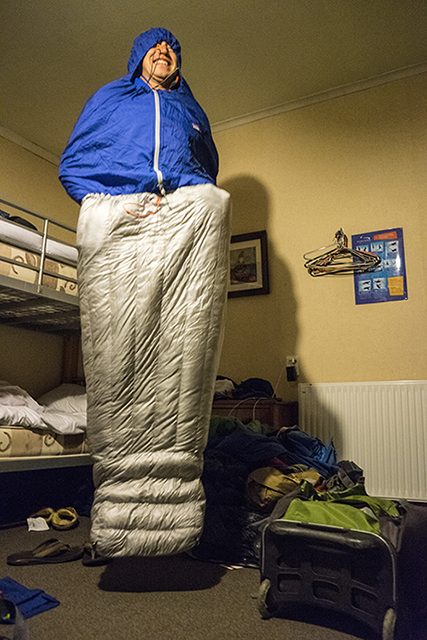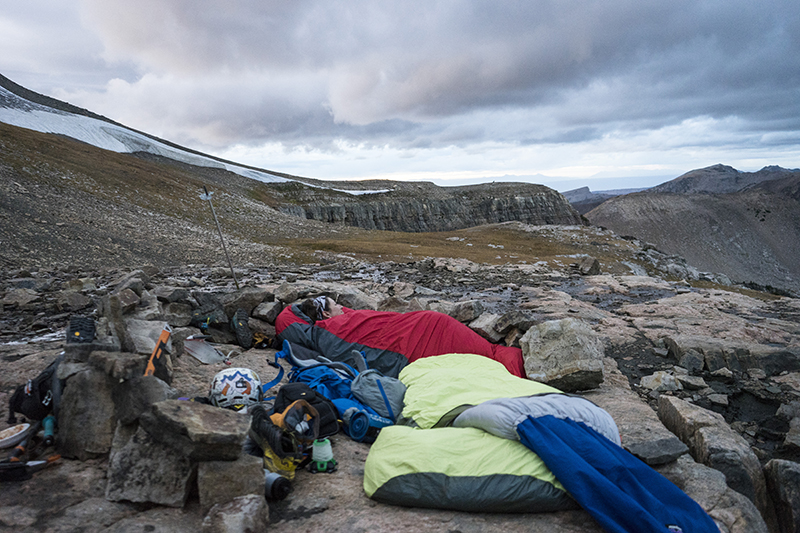
Patagonia Hybrid Sleeping Bag
Temperature Rating: Dependant on the Jacket it’s paired with
Fill Power: 850+
Stated Weight: 490 g (17.3 oz)
Blister’s Measured Weight: 521 g (18.38 oz)
MSRP: $299
Nights Tested: ~20
Test Locations: New Zealand, Idaho, Wyoming, Nevada, California
Intro
While Patagonia has made a wide variety of down insulating products over the years, they hadn’t ever made a sleeping bag. Till now.
I was very excited when I saw the simply-named Hybrid Sleeping Bag because I’d been contemplating switching to an elephant foot system like the Hybrid for some time, but had held off due to the drawbacks we noted in our review of the Brooks Range Elephant Foot. Patagonia’s Hybrid Sleeping Bag solves the worst of those issues, and, at this point, if I could only own one sleeping bag for everything I do in the mountains, year round, I would choose the Hybrid.
Why is There Only Half A Sleeping Bag?
The first thing you’ll notice about the Hybrid Sleeping Bag is that the top half is simply a thin, uninsulated shell, while the bottom half is the typical baffled, well-stuffed, down-insulated bag you’d expect. Basically, the Hybrid builds on the idea that if you’re already bringing an insulating layer for your upper body, that portion of the sleeping bag is redundant, and is just unnecessary weight you’re hauling around the hills. So the Hybrid is designed to work in conjunction with a belay jacket — the bag insulates your legs, overlaps with the belay jacket around your waist, and the thin upper shell of the Hybrid helps keep everything in place.

In addition to cutting your overall weight, the modular nature of the Hybrid allows it to be adaptable to some extent to varying conditions. Over the course of this review, I’ve used the Hybrid with (a) just a base layer on top, (b) with the Patagonia Stretch Nano Storm on top, and (c) paired with a full-on belay jacket, all depending on the outside temperature.
Insulation
Patagonia doesn’t give a standardized insulation rating for the Hybrid, but cites numbers somewhere around 10-15° F as the low end. While I haven’t been able to use the Hybrid at temperatures that cold yet, I have used it in below-freezing conditions, and haven’t experienced cold feet, even when wearing only a base layer and light shell pants with socks and no booties.
So far, the limiting factor temperature-wise has definitely been whatever I’m wearing on top, and once I’ve added a layer on my upper body, I’ve been very warm and slept soundly. I’ll update, however, once I get the Hybrid out in some truly cold conditions.
Weatherproofing
All of the exterior material of the Hybrid Bag has a DWR coating, and Patagonia says about the top half of the bag that, the “Ultralightweight Pertex Quantum shell uses interlocking Y-shaped nylon fibers to enhance the performance of the DWR.” They don’t claim to have treated the down with any hydrophobic substance.
While I haven’t spent a night outside in just the Hybrid bag (I’ve always used a tent or bivy bag so far) I have been impressed with its water resistance. I had two occasions where things got pretty moist, once while sleeping 100 feet from the ocean (in a tent, while hacking and coughing so badly that I completely saturated the inside of my tent with condensation, and found that all my extra clothes were wet), and once while bivvying in the Tetons on a sprinkly night, I soaked the inside of my bivy bag to the point where I expected it to have standing water inside. In both cases, everything else in my tent and bivy was soaked, but the DWR on the bag was still beading, and as far as I could tell, the insulation wasn’t wet at all. I’ve had my DWR-coated Big Agnes bag almost completely wet out in similar conditions. I’ll update this review if I run into any issues in wetter situations, though.
Weight / Packability
This is where the Hybrid really excels. At just 18 oz, it’s lighter than just about any other 15° bag out there, except for ultralight quilts and the Brooks Range Elephant Foot. There are other bags that have a similar weight like Feathered Friends Vireo and Vireo UL, but they are rated for much warmer temperatures.
Of course, how much weight savings you’re actually getting depends on what jacket you pair it with, and whether you’d be bringing that jacket along anyway. For example, when I pair it with my Mountain Equipment belay parka, my total weight for the bag and jacket sits right around three pounds. That’s comparable to several other 15° bags on the market.
If you usually don’t bring a belay jacket, or you run cold and need to sleep in your jacket and a regular bag, the Hybrid may not make as much sense, since your weight savings will not be as dramatic.
The Hybrid packs down to about 11” long by 6” in diameter, which is much smaller than most full 15° bags, and competitive with many summer bags. But again, you do have to factor in the size of your jacket, unless you would already be bringing it along.
Performance
The biggest reason I’ve stayed away from ‘elephant’s foot’-type bags like the Brooks Range is that the suspender system used to keep the bag on seemed uncomfortable and impractical. I’m a very active sleeper, and I could already imagine the cold air seeping into every seam as I thrashed through the night. The Hybrid bag’s hooded shell solves this issue completely. Once I’m in the bag, I pull my jacket down below the top of the down portion of the bag, cinch the draw cord at the waist, and then zip up the top like I would on a regular bag. I’ve found that I’m very nearly as comfortable in the Hybrid, even on nights where I thrash around and sleep talk till dawn, as I am in my regular sleeping bag.
One of the drawbacks Dave mentioned in his review of the Elephant Foot is that it can be difficult to figure out where to put your hands to keep them warm. I’ve ended up either hugging myself, or jamming them down into the lower, insulated portion of the bag. You could try wearing mittens, but that seems awkward. It took me about two hours to get used to sleeping in the Hybrid, but once I did, I quickly became just as comfortable with it as I am in my normal bag.
Four Season Use
I’ve used the Hybrid Bag in a weird variety of situations this fall. I’ve slept on couches in it with just a base layer on top; I’ve camped in warmer temps using just my Stretch Nano Storm on top; and I’ve bivied in it with a full belay jacket. In the past, I’ve used my 20° Big Agnes bag across a similar range of conditions, but in every situation, other than absolutely frigid nights, I’ve found the Hybrid Bag to be more practical and packable, without sacrificing comfort.
While I wish I could afford a quiver of sleeping bags for every occasion and season, I can’t, and I also can’t totally justify owning that many niche, season-specific products that utilize a lot of down. That’s why in the past I’ve just owned one bag that I’ve unzipped into a quilt in the summer, then layered up under in the winter, because there was only about one week a year where its temperature rating matched my situation. That meant I was carrying extra weight most of the summer, and then was under-insulated in the winter.

With the Hybrid Bag, my system is more adaptable and more customizable. Because I’m a photographer, I almost always have a warm jacket with me since I spend a lot of time waiting for the light, for athletes to get in place, etc. In the summer, I plan on using the Hybrid with a light puffy that I typically bring anyway; in the fall, I’ll step up to heavier jacket; and in the winter, I’ll go full-on ‘A Christmas Story’-style mummy. So far I’ve only had one night where my legs got uncomfortably warm and sweaty, and that’s because I was sleeping next to the fireplace. Otherwise, I haven’t found a situation where I’d rather be using a 50° bag or something similar.
The one piece that might be more practical, lighter, and more packable than the Hybrid Sleeping Bag is a quilt system, but I don’t have experience with any yet so I can’t say.
Most of us already own a range of jackets for year-round activities, and with the Hybrid Bag, you can use that quiver to adapt one bag to year-round conditions.
Price
At $299, the Hybrid isn’t cheap. But it is competitive with or cheaper than most other bags with a similar temperature rating, while being much smaller and more packable. It’s cheaper than the Brooks Range Elephant Foot, and in my opinion, its hood is infinitely more practical than the Elephant Foot’s suspenders.
However, you do have to factor in the price of a belay jacket to the overall price of your sleep system. If you don’t already own one, then you’re looking at a significant investment.
And that point really holds true with every aspect of the Hybrid bag. If you already own — and typically bring — an appropriately insulated jacket on your missions, then the Hybrid is lighter, smaller, cheaper, and more adaptable than a traditional sleeping bag. However, if you’re just figuring out your sleep and travel insulation system, the Hybrid Bag may not be the simplest choice.
Bottom Line
Patagonia’s first foray into sleeping bags is impressive. The new Hybrid Sleeping Bag’s upper shell makes it a very good option for fast and light objectives, where a light pack and minimalist bivy are required. But its modular design also makes it one of the more versatile bags on the market for year-round use.

Have you tested the bag in colder conditions yet?